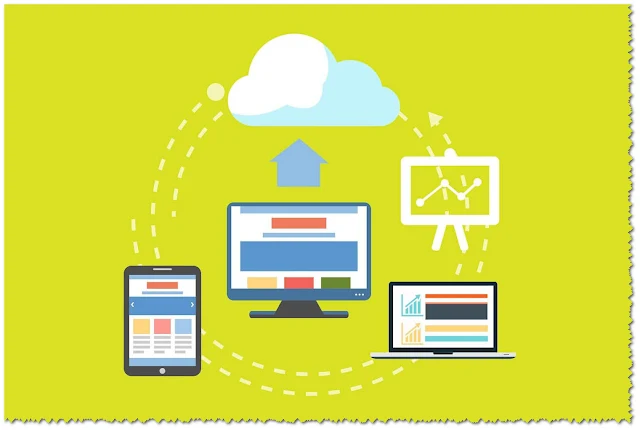cloud based server backup solutions
Cloud-based server backup solutions refer to services offered by cloud providers to backup and store data from servers in the cloud. cloud based backup solutions for small business These solutions allow businesses to automatically back up critical data and applications from their servers to a remote location in the cloud, which can be accessed anytime and from anywhere over the Internet.
 |
| cloud based server backup solutions |
Cloud-based server backup solutions provide several benefits over traditional backup methods. First, they eliminate the need for physical backups, such as tape drives or external hard drives, that require manual intervention and can be prone to failure or loss. Second, they offer a more scalable and flexible solution, allowing businesses to easily increase or decrease storage capacity as needed. Third, they improve data security by encrypting data in transit and at rest, and providing secure access controls.
Overall, cloud-based server backup solutions are an effective way for businesses to protect their critical data and ensure business continuity in case of unexpected disasters or system failures.
Cloud-based server backup solutions are becoming increasingly popular as more businesses move their critical data and applications to the cloud. These solutions provide a secure and cost-effective way to protect your business against data loss, hardware failure, and other disasters.
Some popular cloud-based server backup solutions include:
1- Amazon Web Services (AWS) Backup: This service provides a centralized backup solution for AWS resources, including EC2 instances, EBS volumes, RDS databases, and more.
2- Microsoft Azure Backup: This service offers backup and recovery of on-premises and cloud-based workloads, including virtual machines, SQL Server, SharePoint, and more.
3- Google Cloud Backup: This solution provides backup and recovery for Google Cloud Platform resources, including Compute Engine, Cloud Storage, Cloud SQL, and more.
4- Veeam Backup & Replication: This solution provides comprehensive backup and replication for virtual, physical, and cloud-based workloads, including VMware, Hyper-V, AWS, and Microsoft Azure.
5- Carbonite Safe Server Backup: This solution provides automatic backup and recovery for Windows Server environments, including Exchange, SQL Server, and SharePoint.
When choosing a cloud-based server backup solution, it's important to consider factors such as reliability, security, scalability, and ease of use. You should also ensure that the solution meets your specific backup and recovery needs, including recovery time objectives (RTOs) and recovery point objectives (RPOs).
6- Backblaze B2: This solution offers affordable object storage that you can use to back up your servers and other data. You can use third-party backup software or Backblaze's own tool to interface with the service.
7- Acronis Backup Cloud: This solution offers cloud-based backup and recovery for physical and virtual servers, workstations, and mobile devices. It also includes features such as ransomware protection, blockchain notarization, and more.
8- Barracuda Backup: This solution provides backup and recovery for on-premises and cloud-based environments, including VMware, Hyper-V, AWS, and Microsoft Azure. It also includes built-in replication and cloud archiving capabilities.
9- Code42 CrashPlan: This solution offers cloud-based backup and recovery for endpoint devices, including laptops, desktops, and mobile devices. It also includes advanced features such as data deduplication, smart bandwidth throttling, and more.
10- Druva Phoenix: This solution provides backup and recovery for physical and virtual servers, as well as cloud-native workloads such as AWS and Microsoft Azure. It also includes global deduplication, automated disaster recovery, and more.
When choosing a cloud-based server backup solution, it's essential to evaluate each product carefully to determine which one best meets your needs. Factors to consider include cost, ease of use, scalability, reliability, and security. Finally, keep in mind that the right backup solution is only one piece of an efficient disaster recovery plan – so be sure to have a comprehensive plan in place that addresses all potential risks.
 |
Some popular cloud-based server backup solutions include |
whate is a cloud-based backup solution
A cloud-based backup solution is a type of data backup service that allows users to store their important files and data on remote servers that are managed by a third-party provider. These solutions use the internet to securely transfer data from a user's device to remote servers located in data centers. Cloud-based backup solutions offer several benefits over traditional backup methods, such as on-premise backup or physical media backups like external hard drives. These benefits include automated backups, scalability, offsite storage, and easy accessibility from anywhere with an internet connection. Additionally, cloud-based backup solutions can provide options for encryption and multi-factor authentication to ensure the security of the backed-up data.
whate are thetypes of cloud backup methods
There are several types of cloud backup methods, including:
1- Full backup: This method involves backing up all data and files to the cloud storage system.
2- Incremental backup: This backup method only backs up files that have changed since the last backup.
3- Differential backup: Similar to incremental backup, this method backs up files that have changed since the last full backup.
4- Mirror backup: This method creates an exact copy of the original files and stores them in the cloud storage system.
5- Continuous backup: This method continuously backs up files as they are changed or created, providing real-time protection.
6- Hybrid backup: This method uses a combination of local and cloud-based backup systems to provide redundancy and ensure data recovery.
Each of these methods has its advantages and disadvantages, and choosing the right one depends on your specific needs and budget.
What are a few cloud-based backup services?
1- Microsoft Azure Backup: This cloud backup solution from Microsoft offers flexible and reliable data protection for on-premises and hybrid environments.
2- Google Cloud Storage: A cloud storage platform that provides durable and highly available object storage.
3- Dropbox: A file hosting service that offers cloud storage, file synchronization, and client software.
4- Backblaze: This is a cloud backup service that offers unlimited storage and automatic backups of your files.
5- Carbonite: A cloud backup service designed for small businesses that provides automatic cloud backup of critical data.
6- CrashPlan: A cloud backup service that offers unlimited storage and continuous backups.
7- IDrive: A cloud backup service that offers both personal and business plans with features such as incremental backups, versioning, and remote management.
8- Amazon S3: A popular cloud storage service that offers secure and scalable object storage.
These are just a few examples of cloud-based backup services available in the market. There are many more options out there, each with their own unique features and capabilities.
.jpg) |
What are a few cloud-based backup services |
How do I create a cloud backup server?
To create a cloud backup server, you will need to follow these steps:
1- Choose a cloud storage provider: There are many cloud storage providers such as Amazon S3, Google Cloud Storage, Microsoft Azure, etc. Choose one that suits your needs and budget.
2- Set up an account: Create an account with the cloud storage provider of your choice.
3- Install backup software: You will need to install backup software on your local machine or server. Some popular options include Duplicati, Bacula, Arq Backup, and many more.
4- Configure backup software: Once you have installed backup software, configure it to access your cloud storage account using the credentials provided by the cloud storage provider.
5- Schedule backups: Configure the backup software to schedule backups according to your preferences. You may want to back up your data once a day, once a week, or at some other interval.
6- Monitor backups: Check your backups regularly to ensure they are working properly. If there are any issues, address them immediately.
7- Restore from backups: If you ever need to restore your data from the backup, simply use the backup software to restore the files to your local machine or server.
Overall, creating a cloud backup server is a fairly straightforward process. Just make sure to choose a reliable cloud storage provider and use reputable backup software to ensure your backups are secure and reliable.
What are the 3 forms of backup solutions?
The three forms of backup solutions are:
1- Full Backup: This type of backup solution creates a complete copy of all data and stores it in a different location, such as an external hard drive or the cloud. Full backups are typically performed on a regular basis, such as daily or weekly.
2- Incremental Backup: This type of backup solution only copies the data that has changed since the last backup, rather than copying all data. Incremental backups are more efficient than full backups but require more time to restore files.
3- Differential Backup: This type of backup solution is similar to incremental backup, but it copies all data that has changed since the last full backup, rather than the last backup. Differential backups are faster to restore than incremental backups but require more storage space.
What are examples of cloud solutions?
There are numerous cloud solutions available, some of the most popular ones are:
1- Amazon Web Services (AWS)
2- Microsoft Azure
3- Google Cloud Platform
4- IBM Cloud
5- Oracle Cloud Infrastructure
6- Salesforce Cloud
7- Dropbox
8- Box
9- iCloud
10- OneDrive
These cloud solutions offer a range of services such as computing power, storage, networking, database management, analytics and more. They are designed to help organizations of all sizes manage their IT infrastructure efficiently, cost-effectively and securely.
How many types of cloud storage backups are there?
There are several types of cloud storage backups, including:
1- Full backup: A complete copy of all data and files is stored in the cloud.
2- Incremental backup: Only the changes made since the last backup are stored in the cloud.
3- Differential backup: Similar to incremental backup, but it stores the changes made since the last full backup instead of the last incremental backup.
4- Mirror backup: An exact replica of the data is stored in the cloud, but it does not compress or encrypt the data.
5- Hybrid backup: It combines local and cloud backups to provide a comprehensive backup solution that protects against data loss from multiple sources.
6- Server backup: It is a type of backup that is designed specifically for servers, which often store large amounts of critical data.
7- Continuous data protection (CDP): A real-time backup solution that automatically creates an up-to-date backup of data as changes are made.
How do I convert my physical server to cloud?
To convert a physical server to the cloud, you need to follow these steps:
1- Choose a cloud service provider: There are many cloud service providers available such as Amazon Web Services (AWS), Microsoft Azure, Google Cloud Platform, etc. Choose a provider that meets your requirements.
2- Create an account with the cloud service provider: Once you have chosen your preferred cloud service provider, create an account and sign in.
3- Select the virtual machine: After signing in, select the option to create a new virtual machine. This will allow you to create an instance of the operating system that is running on your physical server.
4- Configure the virtual machine: You will need to configure the virtual machine to match the specifications of your physical server. This includes selecting the operating system, setting up storage, and configuring networking.
5- Install applications and transfer data: Once the virtual machine is configured, install any necessary applications and transfer your data from your physical server to the virtual machine.
6- Test and go live: Test the virtual machine to ensure everything is working correctly. If everything is working fine, you can go live by switching off the physical server and routing traffic to the virtual machine.
Note: It's important to consult with a professional or experienced personnel while performing the migration process to avoid any data loss or other issues.
